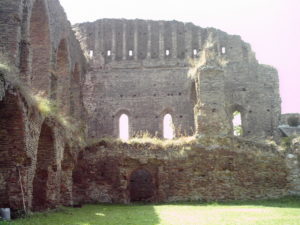Szelindek

In Szelindek (Stulzenbrich, Slimnic), there is a castle and a fortified church. The settlement is in Transylvania, Romania. The fort and the fortified church standing close to the castle hill belonged to the Saxon inhabitants who took shelter in them in perilous times. The name “szelindek” has a South-Slavic origin, the word is derived from “slednik”, a kind of very good hunting dog. The German word Stolchumbercht appeared first in 1282, it was mentioned as Stolczenberg in 1302; Zelenduk (1341); Stolcumberg (1342); Stolczenburg (1409), Nagyzelyndek (1500), Zelendek (1514); Stoltzvár (1569). The German word stands for “proud castle”.

Szelindek belonged to the Saxon Seat of Szeben (Sibiu, Hermanstadt), its castle was a typical “peasant castle”. It is situated in the middle of the settlement on a 50-meter-high hill. It is thought to have been built by a “geréb” family in the 14th or 15th century. The word “geréb” comes from the German word for Gräve (Graf=Comes), they were higher-ranked German Saxon soldiers or officers in the Middle Ages in Transylvania. The village of Szelindek used to be a free Saxon village. It must have been King Lajos I of Hungary around 1370 who allowed the building of the castle, its role was to guard the road between Szeben and Medgyes. However, there already had to be a fortification after 1282.

The fort was built of bricks and it was used by the peasants of the village in case of peril. The northern wing is the oldest part where the 12X12 meter old tower can be seen. There is an arched hall on the eastern side of the tower while another tower can be found on the western side. This tower was last renovated in the first decade of the 18th century. The main entrance of the castle must have been in the northeastern corner of the fort, a tower gate used to stand there in the 1870s.

The palace buildings were built a bit to the south, the first floor was 3-meter-high while its second floor was 5-meter-high. The well of the castle is 70 meters deep. There is a wing on the southern part of the fort, its walls were built by the peasants in the 16th century. These walls surrounded a so-called “cattle yard” where the animals were kept during war, and it was guarded by a round bastion and a tower. The interlinking wall sections that used to stand in the middle were pulled down in the 19th century because the stones were needed for building a wall around the cemetery.

As for the fortified church, it was built in the Gothic style in the 15th century, without a tower. However, the church that was devoted to Saint Bertalan, was probably built in the 13th century. The walls of the fortified church had been continuously enlarged and reinforced until the end of the 18th century.

After the Battle of Mohács (1526), the Saxons sided with King Habsburg Ferdinand and did not willingly accept King Szapolyai János, the previous voivode of Transylvania. Szelindek castle was mentioned in 1529 when the troops of King Szapolyai János took it. At that time, the castle was defended by the Royal Judge of the Saxons, Markus Pemfflinger. However, when Szapolyai’s general, Báthori István left the place, the Saxon army, led by Marton Hahn, took the fort back a day later: they attacked it at night and surprised the guards. The army of Székely Mózes took it away from the Saxons in 1602. (Please, note that I use the Oriental name order for Hungarians where family names come first.)

Later, Szelindek was on the property of Prince Rákóczi György II. Due to the unlucky Polish war of the prince, the Ottomans and the Crimean Tatars were punishing Transylvania. The Turks raided the village of Szelindek in 1658, and the Tatars did the same in 1668. Thankfully, the inhabitants survived these attacks behind the solid walls of the castle. The Hungarian “kuruc” rebels of Prince Rákóczi Ferenc II took the castle in a sudden attack in 1705. Unfortunately, they seriously damaged the castle when they left it in 1707. They exploded it with gunpowder and burned it to prevent its military use in the future. The peasants began to repair the walls in 1715 but the work was quit in 1719 because of a plague. Since then, the walls have been decaying.
Szelindek was the place where the famous Hungarian poet, Petőfi Sándor joined the army of General Bem József during the Hungarian Revolution. Petőfi was coming from Debrecen and arrived in Szelindek on 25 January 1849, just a day later of a battle that was fought near Szelindek. The Polish general was successfully repelling the attacks of the Habsburg troops led by General Puchner six days later, too.

There were 1341 Saxons in the settlement in 1900. Hundred years later there were only 29 of them. Now, the rest of the bricks and stones are being used by the locals for building their houses. Sometimes they organize weddings and receptions in the yard of the castle.

Dear Readers, I can only make this content available through small donations or by selling my books or T-shirts.
If you like my writings, please feel free to support me with a coffee here:
You can check out my books on Amazon or Draft2Digital, they are available in hardcover, paperback, or ebook:
https://www.amazon.com/dp/198020490X or at https://books2read.com/b/boYd81

My work can also be followed and supported on Patreon: Become a Patron!http://Become a Patron!




































